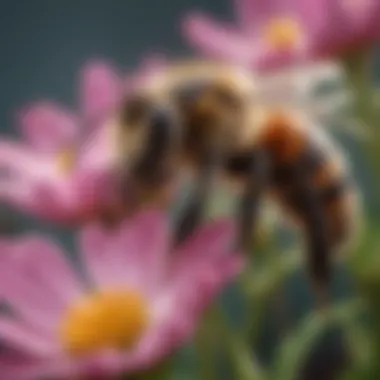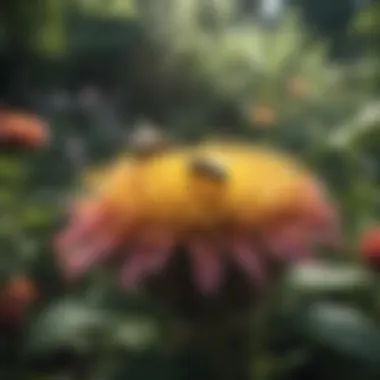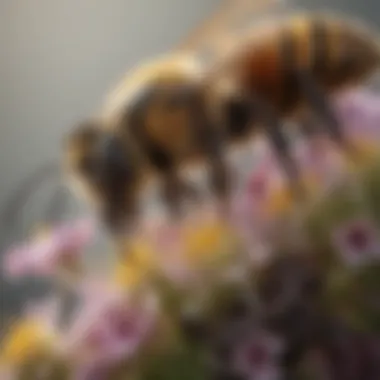The Vital Importance of Bees in Pollinating Flowers


Intro
Bees play a vital role in the complex web of life surrounding us. Their contribution to flower pollination affects both natural ecosystems and agricultural productivity. Understanding this relationship helps underscore the importance of bees in maintaining biodiversity and food security. With about 75% of the world's flowering plants requiring animal pollinators, and bees being among the most effective, knowing more can empower individuals and communities to protect these essential insects.
Research Background
Overview of the Scientific Problem Addressed
Pollination is a critical process for plant reproduction. Insects, particularly bees, facilitate the transfer of pollen from male flower parts to female portions, thus enabling fertilization. This process is not just essential for flowering plants but also has cascading effects on entire ecosystems. The decline of bee populations worldwide poses significant risks to these functions. Factors such as habitat loss, pesticide use, and climate change have contributed to their declining numbers. Addressing these issues is vital for sustaining not only bee populations but also the ecosystems and agricultural systems that rely on them.
Historical Context and Previous Studies
Research on pollination dates back centuries, but it was not until the 20th century that scientists began to grasp the complexity of these relationships. Early studies identified the role of bees in crop pollination. Subsequent research highlighted their behaviors, including foraging and nest building. More recent studies have pointed to the alarming trends of bee population declines. Key investigations by organizations and researchers have uncovered the direct links between pesticide application and bee mortality, as well as the relevance of habitat preservation efforts. Such insights have laid a foundation for ongoing conservation work.
Findings and Discussion
Key Results of the Research
The findings in bee pollination research indicate that diverse bee populations enhance pollination efficiency. A study published in the journal Science highlighted that fields with a variety of bee species show higher crop yields than those with fewer species. Increased bee diversity correlates with improved pollination services, which, in turn, boosts agricultural productivity. This connection underscores the necessity for maintaining diverse habitats that support multiple bee species.
Interpretation of the Findings
Theoretically, if we do not invest effort into sustaining bee populations, we risk not only a loss of biodiversity but also a decline in food security. The reliance on monocultures in agriculture makes these systems particularly vulnerable. When bee populations decline, the yield of crops such as apples, almonds, and blueberries can suffer significantly. Therefore, conservation strategies must encompass both floral resources and habitats for bees to thrive. Preserving native plants and minimizing pesticide use are effective approaches to mitigate these risks.
"Bees are not just insects; they are indispensable players in the survival of our agricultural systems and ecosystems."
Preamble to Pollination
Pollination is a fundamental ecological process that sustains life on Earth. It involves the transfer of pollen from the male part of a flower to the female part, facilitating the reproduction of flowering plants. Understanding pollination is key to appreciating the broader implications of biodiversity, ecosystem health, and food security. With a significant portion of our food supply depending on it, pollination holds immense relevance in contemporary discussions about agriculture and conservation.
Definition of Pollination
At its core, pollination is the act of transferring pollen grains within or between flowers. This transfer occurs through various means, including wind, water, and animals. In many cases, this process is essential for fertilization, leading to the production of fruits and seeds. The specific mechanics of pollination vary among plants and pollinators, which can have implications for the effectiveness and efficiency of the process. More than 75% of the world's crop species rely on pollinators like bees to produce fruits and seeds, underscoring the need for understanding this ecological dynamic.
Importance in Ecosystems
Pollination plays a vital role in ecosystems. It facilitates the reproduction of not only cultivated plants but also countless wild species. This reproductive success contributes to genetic diversity within plant populations, which can enhance resilience against diseases and environmental changes. Additionally, plants that are successfully pollinated provide habitats and food sources for a range of wildlife, creating interdependent relationships within ecosystems. Loss of pollination can lead to declines in plant populations, impacting entire food webs and threatening biodiversity.
Overview of Pollinators
Pollinators, which include bees, birds, bats, and other insects, are crucial agents in the pollination process. Among these, bees are the most effective. They possess specialized structures on their bodies that allow them to collect and transfer pollen efficiently. Understanding the different types of pollinators is essential to grasping the complexity of the pollination process. While bees perform a majority of pollination tasks, other insects and animals contribute to this vital service as well.
Overall, the introduction to pollination paves the way for a deeper exploration into the specifics of bee species, their interactions with flowers, and the overarching significance of their role in sustaining both agriculture and natural ecosystems.
Bees: The Pollinators of Choice
Bees have earned their place as the foremost pollinators in many ecosystems. Their unique biology and behavior contribute significantly to the process of flower pollination. Unlike many other pollinators, bees possess specialized structures that allow them to collect and transport pollen effectively. This enhances the reproductive capabilities of flowering plants, supporting the entire ecosystem.
The efficiency of bee pollination has broad implications.
- Increase in crop yields
- Support of biodiversity
- Maintenance of healthy ecosystems
Understanding the various characteristics of bees and the types involved in pollination gives us deeper insight into their role.
Characteristics of Bees
Bees exhibit a variety of traits that make them especially suited for pollination. Most notably, their hairy bodies are conducive to pollen collection. As they forage for nectar, pollen grains cling to their bodies and transfer from flower to flower. This mutualistic relationship benefits both the plant and the bee.


Bees also demonstrate remarkable foraging behavior. They can communicate the location of resources through pheromonal signals and dances, ensuring efficient foraging within their colonies. Furthermore, bees show a preference for certain flowers, which can enhance the likelihood of cross-pollination among specific plant species.
Types of Bees Involved in Pollination
Understanding the diverse types of bees highlights their contributions to pollination.
Apis mellifera
Apis mellifera, commonly known as the honeybee, is perhaps the most recognized pollinator. Their social structure allows them to efficiently work in groups, resulting in high rates of pollination. Honeybees can visit thousands of flowers in a single day, making them exceptionally effective at pollen transfer.
A key characteristic of Apis mellifera is their ability to communicate the location of resource-rich flowers to their hive mates. This enhances foraging efficiency. However, one must note that their reliance on specific crops can make them susceptible to fluctuations in food availability, which can impact their population.
Bumblebees
Bumblebees are another vital component of bee pollination. Compared to honeybees, bumblebees are larger and have a unique capability to perform buzz pollination. This technique allows them to vibrate their wing muscles, effectively shaking pollen loose from certain flower types.
The key characteristic of bumblebees is their adaptability to cooler temperatures, enabling them to forage earlier in the spring and later in the fall. This gives them an edge in areas where other pollinators are not active. However, their nests are often smaller, leading to a lower population density overall.
Solitary Bees
Solitary bees, as the name suggests, do not live in colonies like honeybees or bumblebees. They are critical pollinators, particularly in wildflower populations. Each female solitary bee typically builds her own nest and provisions it with pollen and nectar for her larvae.
A unique feature of solitary bees is their diverse nesting habits. They may nest in wood, soil, or even within plant stems. This diversity allows them to pollinate a wide range of flowers. A disadvantage, however, is their relatively short lifespan, which limits their period for effective pollination.
The Pollination Process
The process of pollination is fundamental to the reproduction of flowering plants. It serves as the bridge between male pollen and female ovules, enabling the creation of seeds. This section assesses its significance in the context of bee activity. The efficiency of bees in transferring pollen is unmatched by other pollinators. Thus, understanding the mechanics behind pollination can shed light on the ecological balance and agricultural productivity.
Mechanics of Pollination
Pollination occurs when pollen grains adhere to the stigma of a flower. This can happen through various means, including wind, water, and animals, particularly bees. When a bee visits a flower, it collects nectar and inadvertently brushes against the anthers. The sticky pollen attaches to the bee's body. As the bee moves to another flower, the pollen transfers to that flower's stigma, resulting in fertilization.
- Visitation Behavior: Bees generally exhibit flower constancy, meaning they prefer certain flowers during a foraging trip, which enhances pollination effectiveness.
- Pollen Transfer: The transfer can happen with varying effectiveness. Bumblebees, for example, are known to vibrate flowers, helping to release more pollen effectively than other bees.
- Success of Pollination: Not all pollinations result in fertilization, but increased visits by bees can improve fruit and seed set, vital for plant survival.
Flower Traits that Attract Bees
Flowers have evolved various characteristics to entice bees. These adaptations ensure that bees recognize and visit them, enhancing the chances of effective pollination. The following traits are significant:
- Color: Bees are attracted to vibrant colors, especially blue and yellow hues. Some flowers have UV patterns visible to bees which guide them to nectar sources.
- Scent: Fragrant flowers emit specific pheromones. Bees rely on scent to locate flowers, especially at greater distances.
- Shape: Certain flower shapes provide accessible landing platforms for bees. Flower morphology can influence which bee species can effectively pollinate.
The Role of Nectar and Pollen
Nectar and pollen play a crucial part in the pollination process, serving as resources that attract bees. Nectar is a sugary fluid produced by flowers. It provides energy for bees and other pollinators. The significance includes:
- Feeding: Nectar serves as a primary food source for bees, influencing their foraging habits and decision-making processes.
- Pollen as Protein: Pollen is rich in protein and is essential for brood development in bee colonies. Pollen collection is vital for the growth of future generations of bees.
- Mutualistic Relationship: This relationship between flowers and bees is mutualistic. Flowers depend on bees for reproduction, and bees depend on flowers for sustenance.
"Without bees, many flowering plants would not reproduce, leading to loss of biodiversity and changes in ecosystem dynamics."
Understanding the pollination process illuminates not only the role of bees but also highlights the interconnectedness of nature. It emphasizes why conservation efforts around bee populations are crucial in maintaining both ecological integrity and agricultural stability.
Ecological Impacts of Bee Pollination
Bee pollination is a critical component of ecological stability. This section highlights the significance of bees in enhancing biodiversity and sustaining food production. Understanding these ecological impacts informs conservation strategies and emphasizes the urgency of preserving bee populations.
Biodiversity Enhancement
Bees contribute substantially to biodiversity. They facilitate the reproduction of a vast array of flowering plants. Through their pollination activities, bees help maintain genetic diversity. This genetic diversity is essential for ecosystems to adapt to changing conditions and resist diseases.


Flowering plants rely on bees not only for reproduction but also for creating habitats. Many species of plants that thrive in various ecosystems depend directly on bee pollination. For instance, fruit trees, wildflowers, and native plants attract numerous pollinators, thereby promoting the health of the environment. This interplay supports a healthy ecosystem, allowing various species to flourish.
- Key benefits of bee-driven biodiversity enhancement include:
- Increased plant variety: Promotes a balanced ecosystem with more niches.
- Food webs stability: Supports various species that depend on these plants for food.
- Soil health improvement: Encourages plant growth that prevents erosion and enriches the soil.
According to studies, up to 75% of the world's flowering plants rely on animal pollinators, primarily bees.
Impacts on Food Production
The role of bees in food production cannot be understated. They directly contribute to the production of many crops that humans consume. This includes fruits, vegetables, and nuts, significantly impacting global agriculture.
Without bees, the availability of many crops would decrease drastically. A loss of these pollinators could lead to food shortages and higher prices. Many staple foods, such as almonds and apples, rely heavily on bee pollination. Their influence extends beyond quantity to quality, as bee-pollinated crops often exhibit better yields and flavor.
- Crops significantly affected by bee pollination include:
- Fruits: Apples, blueberries, cherries.
- Vegetables: Cucumbers, zucchini, peppers.
- Nuts: Almonds, walnuts.
In economic terms, the contribution of bees to food production is essential. The value of crops directly produced from bee pollination is estimated in the billions of dollars annually. Their continued decline poses a threat not only to biodiversity but also to food security worldwide.
Threats to Bee Populations
Bees play a vital role in ecosystems and agriculture through their pollination activities. However, various threats are putting these crucial pollinators at risk. Understanding these threats is important because it helps identify strategies and actions that can be taken for their conservation. The health of bee populations is directly linked to biodiversity and food production, making this a critical issue that cannot be overlooked.
Pesticides and Chemicals
One significant threat to bees is the widespread use of pesticides and chemicals in agriculture. Neonicotinoids are a class of pesticides that have been linked to bee mortality. These substances affect the nervous system of insects, reducing their ability to forage and navigate. Exposure can happen directly when bees come into contact with treated plants or indirectly through contaminated pollen and nectar.
The prevalence of these chemicals raises concern among researchers and conservationists alike. The farming practices that utilize these substances not only endanger bee populations but also the broader ecosystem.
Habitat Loss
Another critical issue is habitat loss. Urbanization, agricultural expansion, and deforestation result in the destruction of natural habitats where bees thrive. The reduction of wildflower populations and native plants limits food sources for bees, which rely on diverse flora for nectar and pollen.
Moreover, fragmented habitats hinder bee movement. This isolation reduces genetic diversity, which is essential for resilience against diseases and environmental changes.
Climate Change
Climate change is an overarching threat to bee populations. Changes in temperature and weather patterns have profound effects on the flowering times of plants. If flowers bloom earlier or later than usual, it can lead to mismatches between the availability of food and the bees’ life cycle.
Additionally, extreme weather events such as droughts and heavy rains can devastate bee habitats. These changes make it difficult for bees to find the resources they need to survive.
"If we do not address the threats to bees, we may face a decline in pollination services, leading to negative consequences for food production and biodiversity."
Conservation Efforts
Conservation efforts are crucial for ensuring the survival of bee populations and, by extension, the pollination services they provide. Bees play a vital role in maintaining healthy ecosystems and supporting agricultural productivity. The declining number of bees due to various threats calls for urgent action. This section discusses how we can effectively conserve these essential pollinators through multiple strategies, including habitat preservation, sustainable beekeeping practices, and supportive legislation.
Preserving Natural Habitats
Preserving natural habitats is one of the most effective strategies in bee conservation. Natural environments provide food sources, nesting sites, and protection from predators. The loss of these habitats, primarily due to urbanization, agriculture, and deforestation, has had severe impacts on bee populations. Here are some important considerations:
- Creating Protected Areas: Establishing reserves or parks can safeguard areas rich in biodiversity. These areas can function as refuges for pollinators.
- Restoring Degraded Habitats: Restoration projects can revive damaged ecosystems. This can involve planting native flowering species that attract and support bee populations.
- Reducing Agricultural Monocultures: Encouraging farmers to diversify their crops helps create more suitable habitats for bees while also benefiting agriculture.
Beekeeping Practices
Sustainable beekeeping practices are vital for both supporting bee health and ensuring the stability of honeybee populations. When done responsibly, beekeeping can contribute to biodiversity and agricultural productivity. Key practices that promote this balance include:


- Organic Beekeeping: This avoids the use of harmful chemicals and pesticides, which can adversely affect bee health. Organic practices encourage stronger colonies and healthier products.
- Regular Monitoring: Keeping track of bee health through inspections helps in the early identification of diseases and pests, reducing risks of colony collapse.
- Education and Training: Providing resources and training for beekeepers on modern practices ensures they can maintain sustainable colonies while meeting market demands.
Legislation and Policy
Effective legislation and policy play a crucial role in bees' conservation efforts. Governments can implement laws that protect bee habitats and promote practices that support bee health. Here are some potential actions:
- Regulating Pesticides: Imposing strict regulations on pesticide use, particularly neonicotinoids, helps mitigate their harmful effects on bee populations.
- Funding Conservation Programs: Government funding can aid in habitat restoration projects and support organizations working on bee conservation.
- Awareness Campaigns: Promoting public awareness of bee importance can foster community support for local conservation initiatives.
"Without bees, our ecosystems and food systems would face significant challenges. Conservation efforts are essential not just for bees, but for the health of our planet."
In summary, addressing the threats to bees through conservation initiatives is crucial. By preserving natural habitats, promoting sustainable beekeeping practices, and supporting beneficial legislation, we can ensure that bees continue to thrive, ultimately stabilizing the ecosystems they help sustain.
The Future of Bees and Pollination
Understanding the future of bees and their role in pollination is critical for maintaining ecological balance and ensuring food security. As research progresses, several elements emerge that indicate the need for urgent attention and action. We must recognize how shifting environmental conditions, agricultural practices, and urbanization affect bee populations and, consequently, the pollination services they provide.
Bees hold a unique position in our ecosystems. They are not just pollinators; they assist in sustaining agricultural productivity and enhancing biodiversity. The decline in bee populations could spell doom for many plants that rely on them for reproduction, directly affecting food systems and natural habitats. Addressing the future challenges of bee conservation goes beyond simply safeguarding these insects; it involves a comprehensive approach to ecological health as well.
Research Directions
One key area of research focuses on understanding how environmental changes impact bee populations and their foraging behaviors. Scientists are investigating how climate change, pesticide use, and habitat loss influence bee health. Particular interest lies in studying the behavior of species like Apis mellifera and bumblebees under varying conditions. This knowledge is crucial for developing adaptive strategies to protect these pollinators.
Another significant research direction involves the genetics of bees. By exploring genetic diversity, researchers aim to identify resilient bee populations that can thrive in changing environments. This research can guide breeding programs to enhance traits necessary for survival under stressors.
Furthermore, integrating technology in monitoring bee populations is gaining attention. Tools such as remote sensing and ecological modeling can provide data on bee behavior and population dynamics. By employing these advanced techniques, scientists hope to create predictive models that allow proactive measures against population declines.
Engaging Communities
Engaging communities in bee conservation is essential for the future of pollination services. Education and awareness play a pivotal role in inspiring individuals to take action. Schools and local organizations can facilitate workshops that educate the public about the importance of bees. These programs can cover topics such as creating bee-friendly habitats and understanding the ecological role of bees.
Local initiatives like community gardens can also be effective. These gardens serve as practical platforms to cultivate bee-friendly plants, promoting biodiversity and enhancing community involvement in local conservation efforts. Additionally, citizen science projects can encourage community members to participate in data collection on bee populations. Not only does this enhance research efforts, but it also fosters a deeper connection between people and nature.
Mobilizing social media platforms can further amplify these efforts. Communities can use networks like Facebook and Reddit to share successes and challenges, thus building a collective knowledge base that inspires action and fosters community spirit.
"The future of bees and pollination relies heavily on a collaborative approach between scientists and the public, creating a shared commitment to protect our essential pollinators."
By understanding the future direction of bees in ecosystems and fostering community engagement, we can strive toward creating sustainable environments that support bee populations and the vital services they provide.
Practical Actions for Supporting Bees
Bees play an integral role in the process of flower pollination and their decline poses serious risks to ecosystems and food production. Therefore, it is essential that individuals and communities understand ways to support these pollinators. Various actions can be taken to create a favorable environment for bees, both at home and within local communities. These actions not only contribute to the well-being of bees but also promote biodiversity and a more sustainable relationship with nature.
Creating Bee-friendly Gardens
Designing a bee-friendly garden can significantly enhance local bee populations. Such gardens serve as essential foraging grounds where bees can find food and nesting sites.
Here are key considerations when planning a bee-friendly garden:
- Diverse Plant Selection: Choose a variety of plants that bloom at different times throughout the growing season. Native flowers are particularly effective as they are well-adapted to local bee species. Some recommended plants include lavender, sunflowers, and wildflowers.
- Avoid Chemicals: Pesticides and herbicides can harm bees. Consider using organic gardening methods to protect their health. Natural pest control strategies can maintain your garden without damaging bee populations.
- Water Sources: Create small water sources where bees can hydrate. Shallow dishes with pebbles are effective as they allow bees to land safely.
- Nesting Areas: Provide spaces for bees to nest, such as leaving bare soil or using bee hotels. Solitary bees, for instance, often nest in undisturbed soil or hollow stems.
By incorporating these elements, gardens can become safe havens for bees, promoting their health and enhancing local ecosystems.
Educating Others About Bees
Education plays a vital role in ensuring the survival of bees. Raising awareness among peers and community members can lead to broader conservation efforts.
Here’s how you can educate others:
- Workshops and Events: Organize community workshops focused on bees and their importance in pollination. This can include discussions on gardening practices, local bee species, and conservation strategies.
- Social Media Campaigns: Use platforms like Facebook and Reddit to spread information about bees. Create content that outlines their importance and provides tips on supporting their populations.
- Schools and Youth Programs: Collaborate with schools to include bee education in curricula. Engaging students with hands-on activities, like setting up pollinator gardens, can foster long-term interest in conservation.
- Printed Materials: Distribute flyers or brochures that highlight actions everyone can take to help bees. Visual aids that explain how bees contribute to food production and biodiversity are effective teaching tools.
Through consistent education and outreach, communities can foster a deeper understanding of the essential role bees play in our environment and inspire collective action to protect them.
Summary: Supporting bees is no small task, but it begins with practical actions we can integrate into our lives. Creating bee-friendly gardens and educating others about their roles in pollination are two powerful steps that can lead to positive changes for bee populations. This collective effort is crucial for preserving the balance of our ecosystems.







